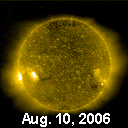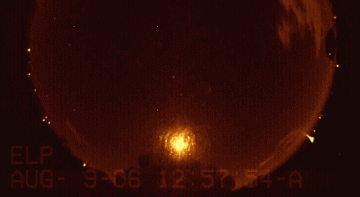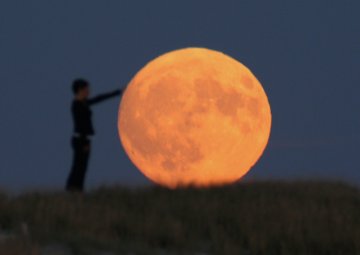|   SPACE WEATHER SPACE WEATHER
Current
Conditions
Solar Wind
speed: 451.9 km/s
density: 2.1 protons/cm3
explanation | more data
Updated: Today at 2244 UT
X-ray Solar Flares
6-hr max: C2 1805 UT Aug10
24-hr: C2 1805 UT Aug10
explanation | more data
Updated: Today at 2245 UT
Daily Sun: 10 Aug '06

A new sunspot, 904, is emerging over the sun's eastern limb. Credit: SOHO/MDI
Sunspot Number: 25
What is the sunspot number?
Updated: 09 Aug 2006 Far Side of the Sun

This holographic image reveals no sunspots on the far side of the sun. Image credit: SOHO/MDI Interplanetary Mag. Field
Btotal: 4.9 nT
Bz: 0.7 nT south
explanation | more data
Updated: Today at 2247 UT Coronal Holes:

There are no coronal holes on the Earth-facing side of the sun today. Credit: SOHO Extreme UV telescope.
 SPACE WEATHER SPACE WEATHER
NOAA
Forecasts
Solar Flares: Probabilities for a medium-sized (M-class) or a major (X-class) solar flare during the next 24/48 hours are tabulated below.
Updated at 2006 Aug 10 2203 UTC
| FLARE | 0-24 hr | 24-48 hr | | CLASS M | 30 % | 35 % | | CLASS X | 05 % | 05 % |
Geomagnetic Storms: Probabilities for significant disturbances in Earth's magnetic field are given for three activity levels: active, minor storm, severe storm
Updated at 2006 Aug 10 2203 UTC
Mid-latitudes | 0-24 hr | 24-48 hr | | ACTIVE | 15 % | 15 % | | MINOR | 05 % | 05 % | | SEVERE | 01 % | 01 % |
High latitudes | 0-24 hr | 24-48 hr | | ACTIVE | 15 % | 15 % | | MINOR | 05 % | 05 % | | SEVERE | 01 % | 01 % |
|  Did you miss the aurora surprise of August 7th? Next time get a wake-up call: Spaceweather PHONE. Did you miss the aurora surprise of August 7th? Next time get a wake-up call: Spaceweather PHONE.
SUNSPOT 904: A large and beautiful new sunspot is emerging from the sun's eastern limb: image. So far it poses no threat for Earth-directed solar flares, but this could change. The spot is growing fast and turning toward Earth. Stay tuned for updates. BRIGHT PERSEIDS: With the Moon glaring in the background, this weekend's Perseid meteor shower is supposed to be a dud. But maybe it won't be so bad after all. All week long, observers have been seeing some bright, early Perseids, such as this one streaking over El Paso, Texas, on August 9th: 
Astronomer Jim Gamble caught the fireball using one of the Sandia Meteor Detection Network's all-sky cameras. The spotlight at the bottom of the image is the full Moon. Versus the moonlight, the Perseid won. "I hope this is a sign of things to come," says Gamble. PERSEID CALENDAR: (all times are local to the observer) -
- Saturday morning, Aug. 12, before dawn: The shower peaks in bright moonlight. Hope for fireballs!
- Saturday evening, Aug. 12, 8:30 - 10 pm: Look again for Earthgrazers.
Can't see any Perseids? Try listening: Our live radar feeds make a "ping" sound whenever a meteor flies over the Naval Space Surveillance Radar in Kickapoo, Texas. HAVING A BALL: Two nights ago, graphic artist "Sabine" was watching the Moon rise over the beach at Treguennec, France, when she was struck by an overpowering thought: "What a great beach ball!" 
Soon, photographer Laurent Laveder caught her rolling, tossing and even kicking the fat, orange orb. Who said astronomy's no fun? "For months, Sabine and I have been talking about playing with the Moon in this way," says Laveder. "And we have many more ideas." The next full Moon: Sept. 7th. Stay tuned. | 
Potentially Hazardous Asteroids (PHAs) are space rocks larger than approximately 100m that can come closer to Earth than 0.05 AU. None of the known PHAs is on a collision course with our planet, although astronomers are finding new ones all the time.
On 10 Aug 2006 there were 800 known Potentially
Hazardous Asteroids July 2006 Earth-asteroid encounters | ASTEROID | DATE
(UT) | MISS DISTANCE | MAG. | SIZE
| | 2004 XP14 | Jul 3 | 1.1 LD | 12 | 600 m | | 2006 BQ6 | Jul 29 | 14 LD | 16 | 500 m | Notes: LD is a "Lunar Distance." 1 LD = 384,401 km, the distance between Earth and the Moon. 1 LD also equals 0.00256 AU. MAG is the visual magnitude of the asteroid on the date of closest approach.
|

